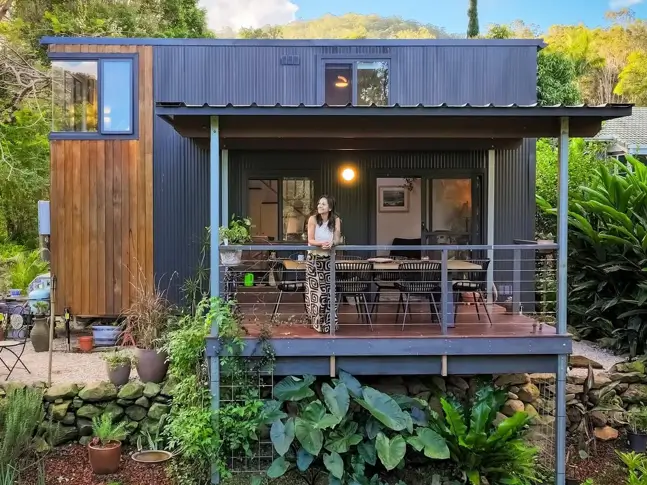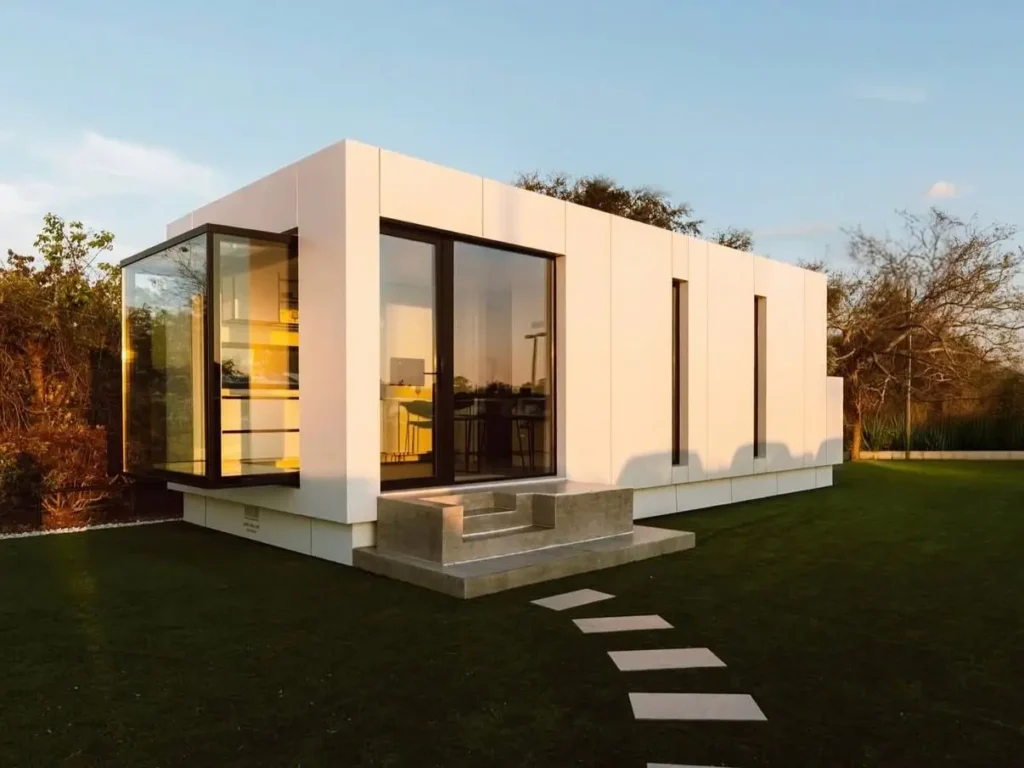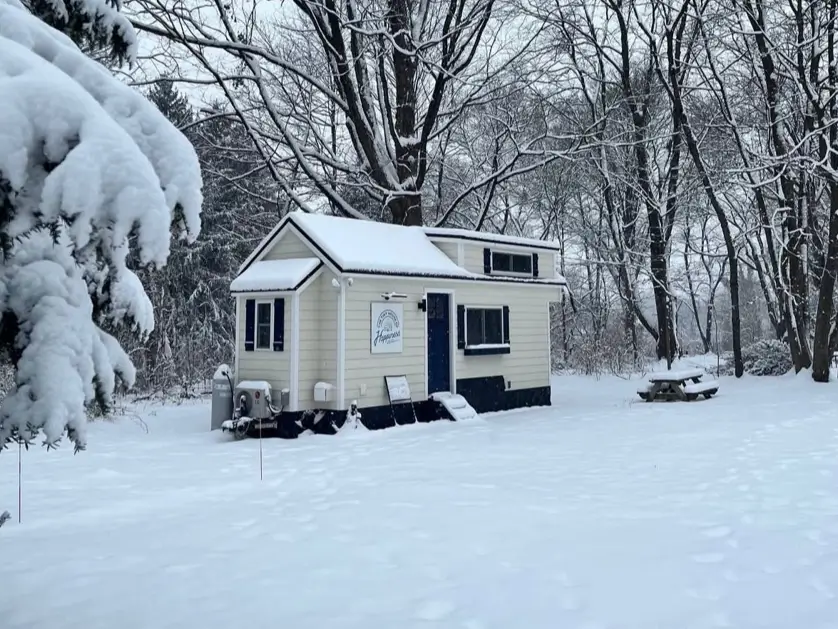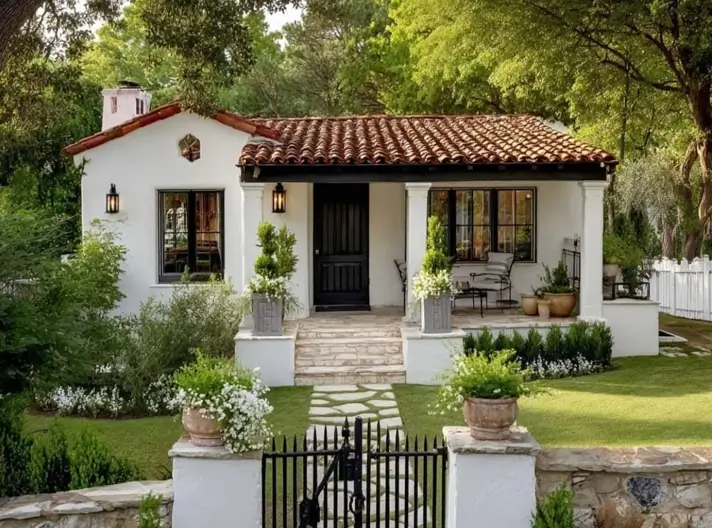Finding the perfect tiny house design ideas is the first step toward embracing a lifestyle of intention and style. Whether you’re drawn to financial freedom, a smaller environmental footprint, or a simpler life, success in compact living isn’t just about a beautiful facade; it’s about creating a harmonious balance between a charming tiny home exterior and a hyper-functional interior that feels spacious and serene.
From rustic cabins to sleek modern abodes, these small house design ideas provide the visual inspiration and practical advice needed to craft your perfect small home. This guide explores a curated collection of styles and dives into the essential principles that make a small space both beautiful and brilliantly livable.
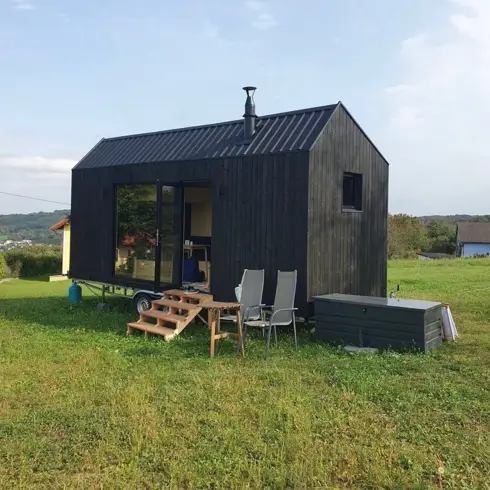
Key Takeaways From This Guide
- Exterior Style Inspiration: Discover 36 distinct tiny home exterior ideas, correctly grouped by style—from classic cottages and rustic cabins to modern A-frames—to find the look that best suits your vision.
- Smart Interior Solutions: Learn foundational principles for designing a tiny house interior that feels spacious, organized, and perfectly tailored to your lifestyle.
- Practical, Actionable Advice: Gain insights into material choices, color palettes, layouts, and space-saving solutions that make a significant impact on a small footprint.
Timeless Charm with Classic Cottage Exteriors
These designs prioritize timeless appeal, intricate details, and a welcoming, storybook feel. They prove that a small footprint can be full of traditional charm and personality.
1. Embrace Classic Cottage Charm

Storybook cottage appeal is achieved through classic architectural elements. This small house design idea features crisp white siding and a dark gabled roof for timeless contrast. Symmetrical dormers and a welcoming front porch enhance the facade, proving that compact living can be full of traditional charm and curb appeal.
2. Go Vertical with Victorian Flair
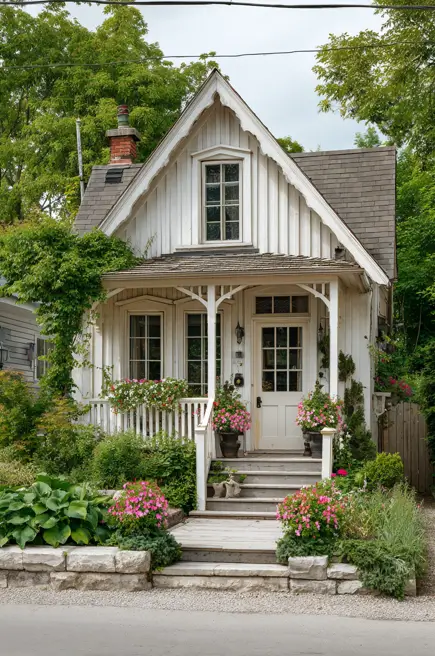
Maximizing height is a clever strategy in small house design, drawing the eye upward to create an illusion of space. This home’s steep gable and board-and-batten siding emphasize its vertical lines, while intricate trim adds a touch of historic character. This vertical approach is key to maximizing living volume on a minimal footprint.
3. Design a Rustic Woodland Retreat
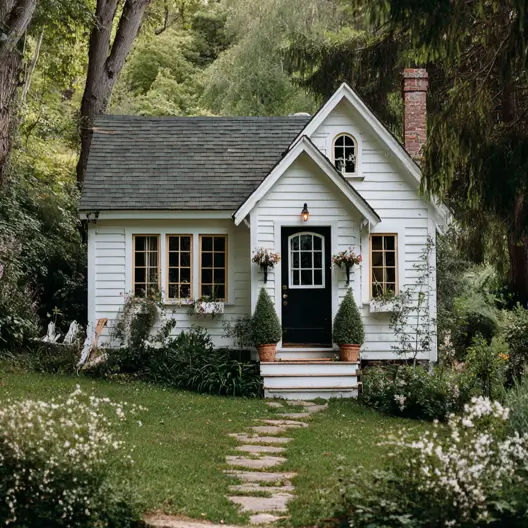
Designing a home to harmonize with its environment creates a tranquil retreat. This tiny home exterior idea features a classic white facade with a contrasting dark door and a brick chimney, all beautifully framed by a lush, natural woodland landscape for a storybook feel.
4. Embrace Storybook Detailing
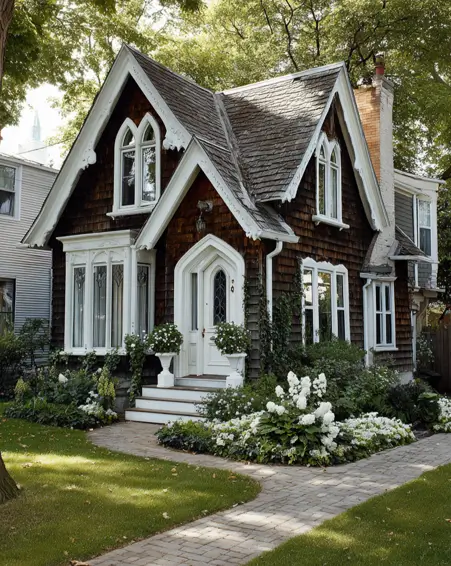
Intricate architectural details can give a small home a grand presence. This storybook cottage uses dark wood shingles and crisp white trim to highlight its Gothic-inspired arches and decorative gables, creating a rich, textured facade that is full of personality and historic charm.
5. Frame with a Flourishing Garden

Lush, layered landscaping can make a small structure feel magical and established. This tiny house design idea uses a vibrant, flower-filled garden to frame the home, adding texture and color that extends the living space outward and beautifully complements the home’s unique purple hue.
6. Select Ornate Victorian Trim

Ornate gingerbread trim adds a layer of intricate detail and personality. This is a classic example of tiny house design ideas that use delicate woodwork on the gables and porch to create a charming, historic feel, proving that even the most compact homes can embrace elaborate decoration.
7. Decorate with Lush Window Boxes
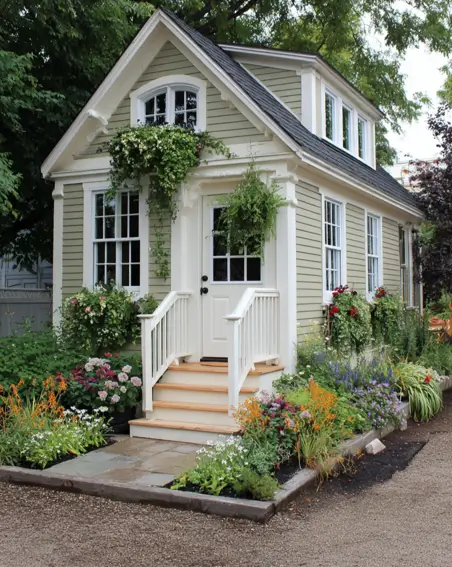
Abundant greenery from window boxes and planters acts as a living decoration for a tiny home. Here, overflowing plants add a lush, vibrant layer to the soft green siding and classic white trim, enhancing the home’s charming and welcoming cottage aesthetic without taking up ground space.
8. Opt for a Timeless Farmhouse Aesthetic
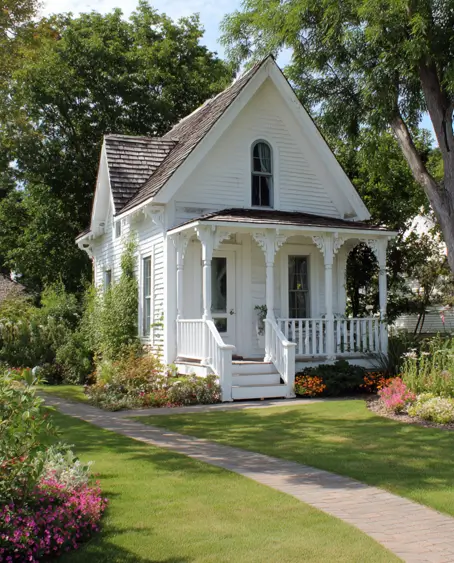
A pristine all-white exterior offers a crisp and timeless look. The monochromatic palette emphasizes this home’s clean lines, steep roof, and decorative porch trim, creating an elegant and striking presence that feels both classic and bright within its garden setting.
9. Lay a Whimsical Stone Pathway
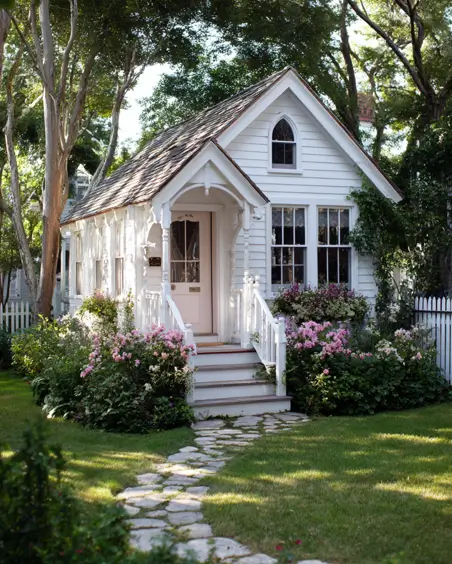
Natural, irregular flagstones create a meandering path that adds storybook whimsy. This organic approach to hardscaping softens the journey to the front door, perfectly complementing the home’s romantic white facade and delicate architectural trim for an enchanting entrance.
10. Stand Out with a Bold Red Exterior
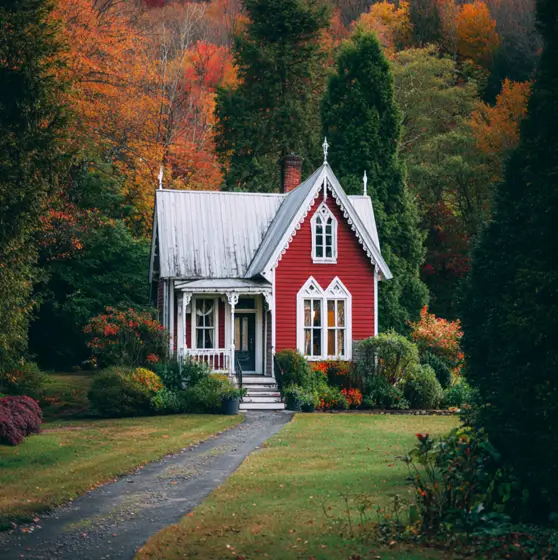
Selecting a vibrant red exterior creates a striking visual statement. This design idea uses the bold color to highlight its Gothic Revival architecture, from the intricate white trim to the elegant arched windows, making it a focal point against the autumn landscape. This approach is particularly effective for small cabin designs in wooded areas.
11. Embrace a Warm, Neutral Palette
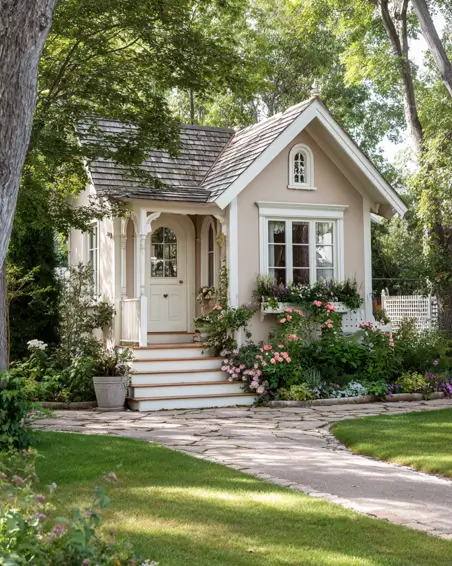
Warm neutral tones offer a sophisticated and inviting alternative to classic white. This small house design idea uses a soft beige hue to create a gentle facade that feels both timeless and warm. Crisp white trim provides a clean outline, enhancing the home’s charming architectural details.
12. Choose a Cheerful, Sunny Hue
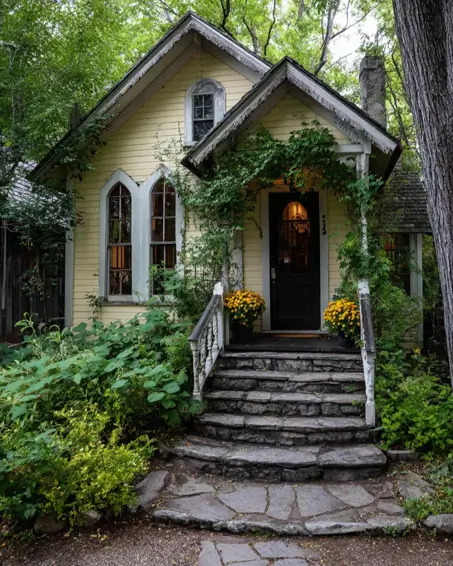
Soft yellow siding offers a cheerful and welcoming tiny house design idea. The sunny color brightens the wooded setting, complemented by natural stone steps and romantic climbing vines. Gothic-arched windows add a touch of whimsy, creating a fairytale cottage that feels both classic and inviting.
13. Build a Storybook Stone Cottage
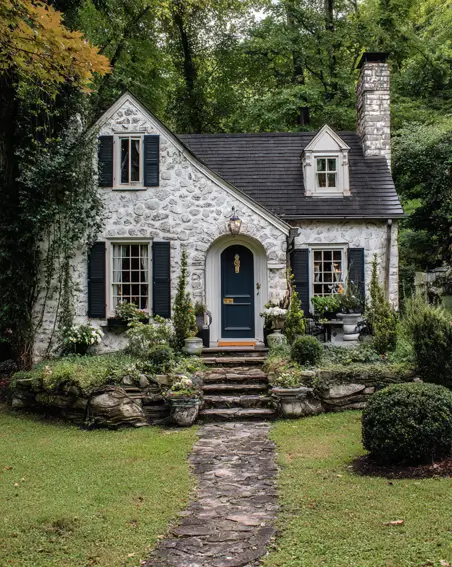
Whitewashed stone, such as fieldstone or river rock, creates a textured, old-world facade that is full of romance. This tiny house design idea uses the substantial material to evoke a timeless European cottage, with a charming arched doorway and dark shutters providing elegant, contrasting details.
14. Add a Classic Picket Fence

Defining the property with a white picket fence adds an element of timeless charm. This is a simple but effective small home design idea that pairs the classic fence with a simple white facade and a warm wood door, creating a picturesque and welcoming entry.
15. Add Definition with Classic Shutters
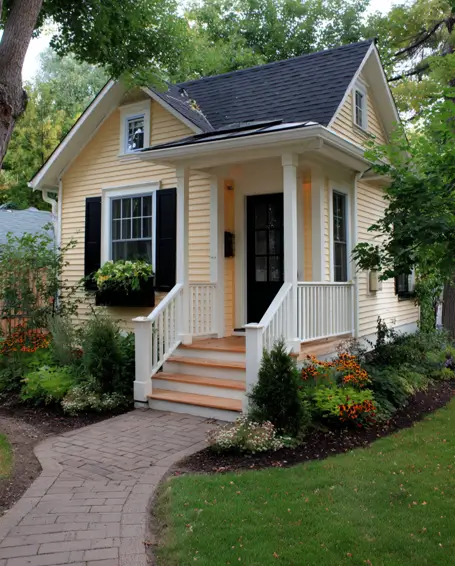
Black shutters provide a crisp, graphic contrast against soft yellow siding. This classic design idea adds a layer of definition and traditional charm, framing the windows and complementing the dark front door for a cohesive and polished exterior look.
16. Frame with Abundant Flower Beds
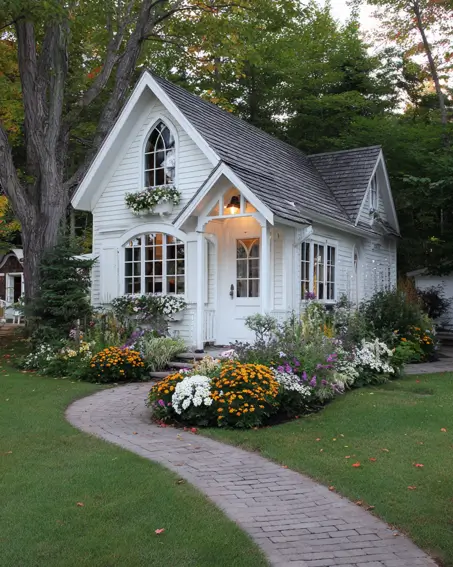
Curving flower beds packed with colorful blooms soften the edges of the landscape. This design uses a brick paver path to meander through the gardens, leading the eye toward the home and creating a lush, inviting entrance that is full of color and life.
17. Design a Rustic Woodland Setting
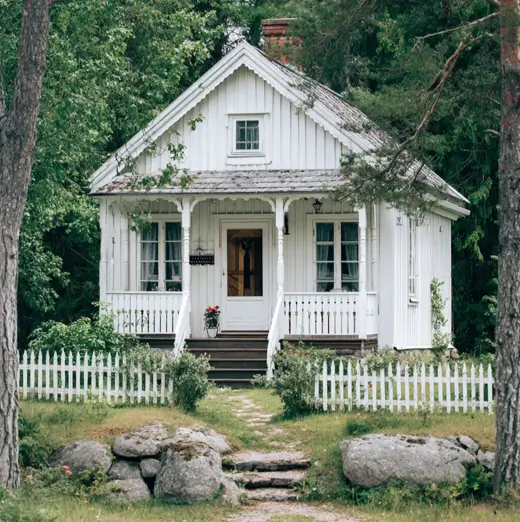
Simple, clean lines and a crisp white facade stand out in a rustic woodland setting. This design uses a classic picket fence to create a charming boundary, while the simple porch and vertical siding maintain a serene and uncluttered aesthetic in nature.
18. Pair Red Siding with a Wood Door
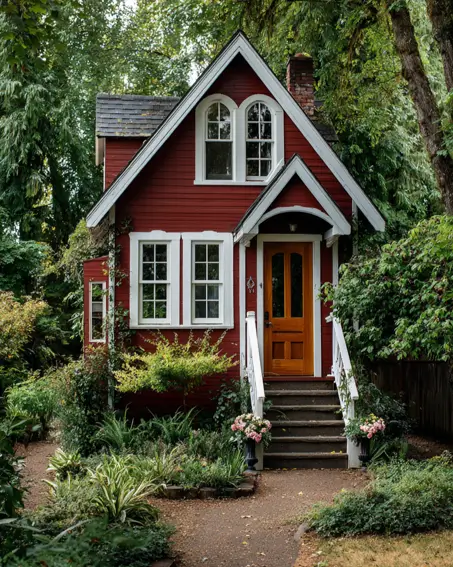
Rich red siding provides a classic, confident color base. This design idea pairs the deep red with crisp white trim for sharp definition, while the natural warmth of the wood-paneled door offers a welcoming and organic touch that balances the bold color.
19. Design a Complex Roofline
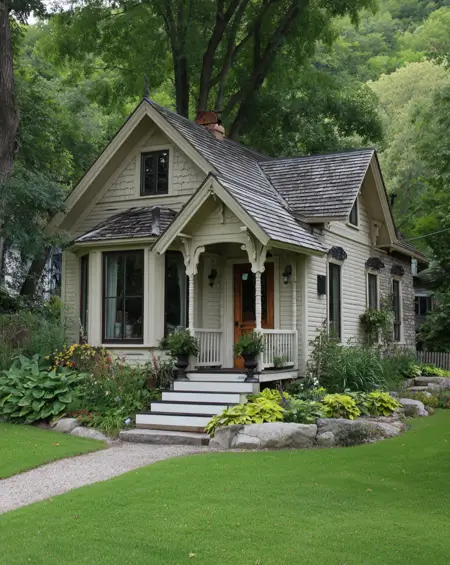
Multiple gables and a bay window add significant architectural character, making a small home feel more substantial. A varied roofline creates visual depth and a dynamic silhouette, enhanced by the textured cedar shake roofing and detailed porch.
Nature-Inspired Rustic & Lakeside Retreats
Focused on natural materials and harmony with the environment, these designs create a sense of tranquil escape, from woodland cabins to waterside homes.
20. Embrace a Natural Wood Exterior
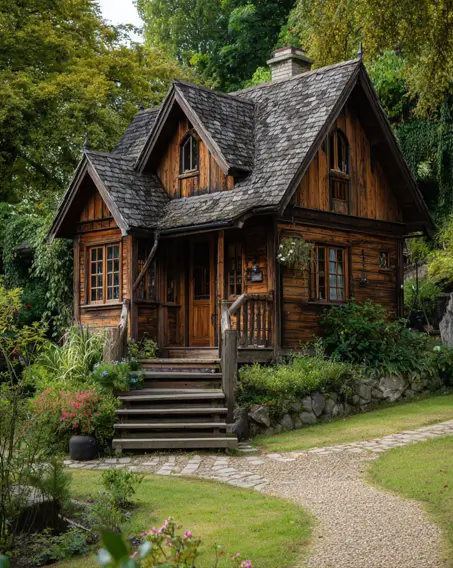
Natural wood siding, like cedar or pine for its resistance to rot, creates a warm, inviting tiny home that blends into its surroundings. Many builders are now using reclaimed wood and other sustainable building materials to enhance this natural aesthetic.
21. Craft a Lakeside Look
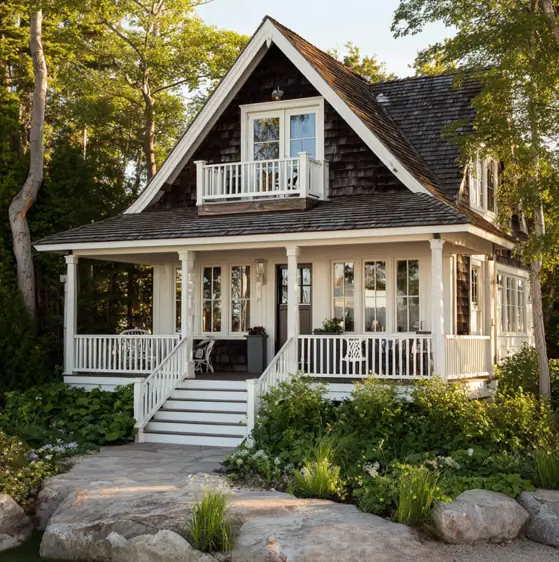
Mixing natural materials creates a relaxed, lakeside feel. This tiny home exterior idea pairs rustic cedar shingles on the upper level with crisp white siding below. A spacious wraparound porch provides ample room for enjoying the view, while a small upper balcony adds a private retreat.
22. Opt for a Dramatic Black Facade
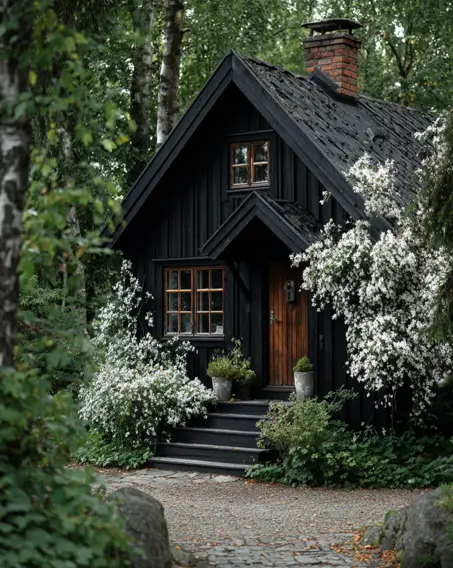
Dramatic black siding creates a modern and moody tiny home exterior. This bold choice allows the natural warmth of the wood-framed windows and door to stand out, providing a stunning backdrop for the vibrant white flowers that frame the entrance.
23. Anchor with a Stone Chimney
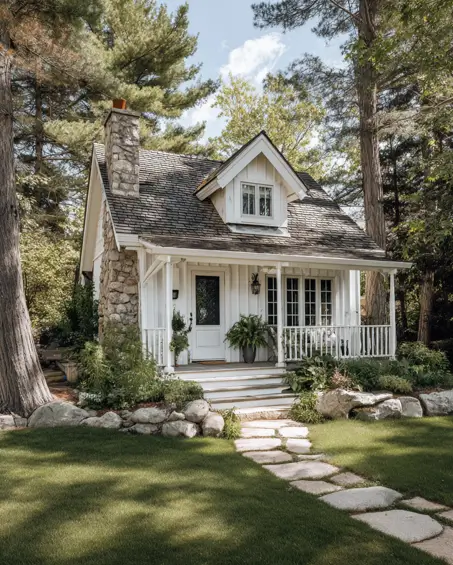
Integrating natural stone adds texture and a sense of permanence. This home’s substantial stone chimney provides a rustic contrast to the crisp white siding and dark roof, creating a focal point that feels both timeless and grounded in its natural setting.
24. Design a Creekside Escape

Building directly over a stream creates a truly unique living experience. This design uses a wraparound deck to maximize the waterside location. A rustic stone chimney grounds the structure, enhancing the feeling of a secluded woodland retreat where nature is always present.
25. Use a Vibrant Exterior Color
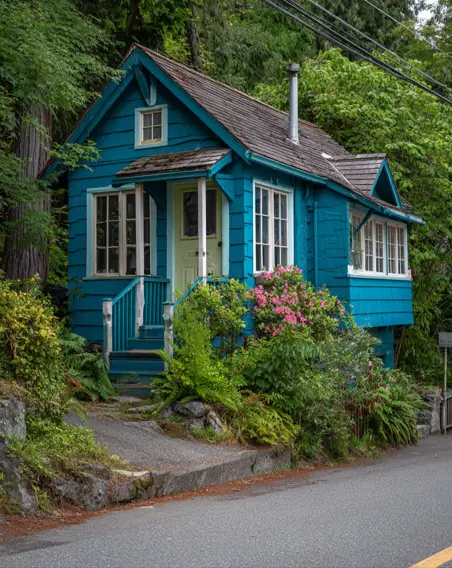
Vibrant color can infuse a small home with a unique personality. This exterior idea features a rich teal shingle siding that stands out beautifully against the lush, wooded backdrop. The playful yet bold hue gives the rustic structure a memorable character.
26. Create Multi-Level Outdoor Living
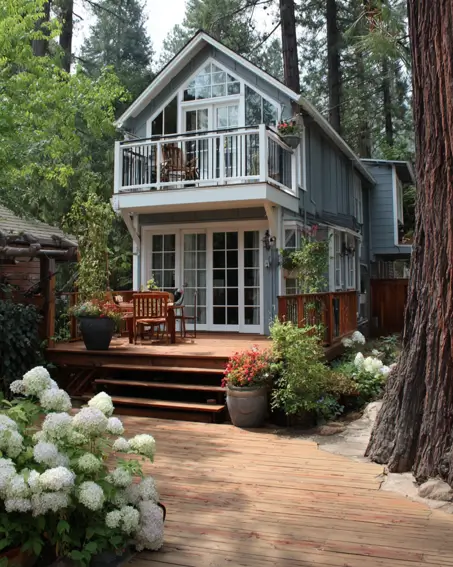
Vertical designs effectively expand living space. This home features a spacious lower deck for dining and a private upper balcony, creating distinct outdoor zones for relaxation while embracing the natural forest setting and connecting the interior with the outdoors.
27. Design a Charming Gable Dormer
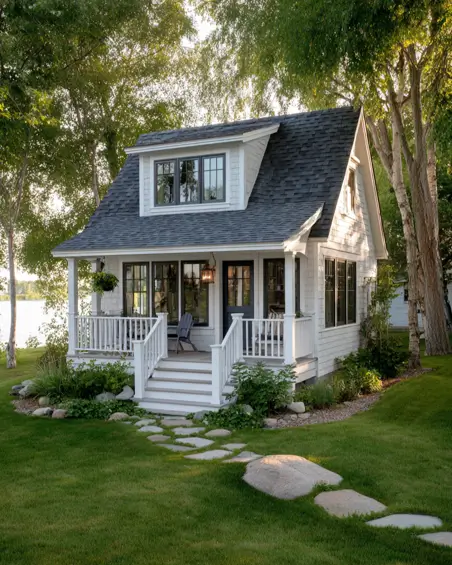
Designing with a large gable dormer creates valuable headroom and light in the upper story. This lakeside tiny house uses the feature to add architectural interest, while the white shingle siding and dark trim create a crisp, modern coastal aesthetic.
Clean Lines in Modern & Contemporary Designs
Characterized by clean lines, bold contrast, and a strong connection to the outdoors, these designs are perfect for those who love a minimalist and contemporary aesthetic.
28. Use a Bold Color Contrast
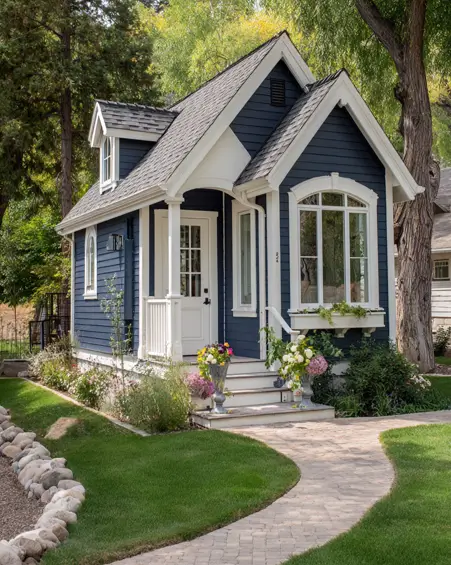
Deep, saturated color palettes offer a sophisticated tiny home exterior idea. The bold navy siding paired with crisp white trim creates a visually stunning contrast that highlights the home’s architectural details, such as the elegant arched window and the charming dormer.
29. Add a Covered Porch
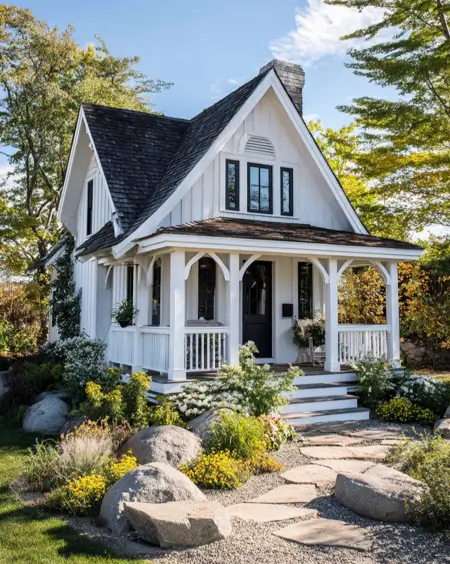
Extending living space with a covered front porch enhances both function and curb appeal. This design pairs clean white siding with bold black accents for a modern look, while a stone chimney and rock landscaping add a touch of rustic texture.
30. Add Dramatic Arched Windows
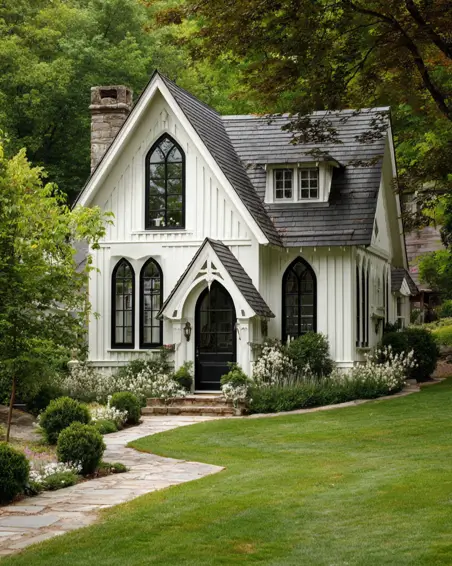
Elegant arched windows serve as a stunning focal point. This design idea uses the dramatic curves of black-framed windows to contrast beautifully with the crisp, white vertical siding and the steep pitch of the roof, lending a touch of gothic romance to a modern structure.
31. Go Modern with an A-Frame

Classic A-frame construction is reimagined with a dark, contemporary exterior and a wall of glass. This striking design maximizes natural light, while the steep pitch of the roof is highly effective at shedding snow in colder climates.
32. Design a High-Contrast Farmhouse
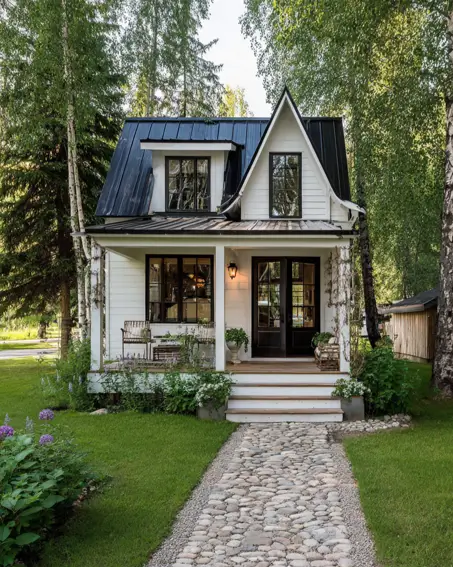
High-contrast palettes define modern farmhouse style. This design pairs a sleek black metal roof with classic white siding. A metal roof is a practical choice, as its durability and relatively lightweight nature make it ideal for both permanent and mobile tiny structures.
33. Integrate an Outdoor Deck
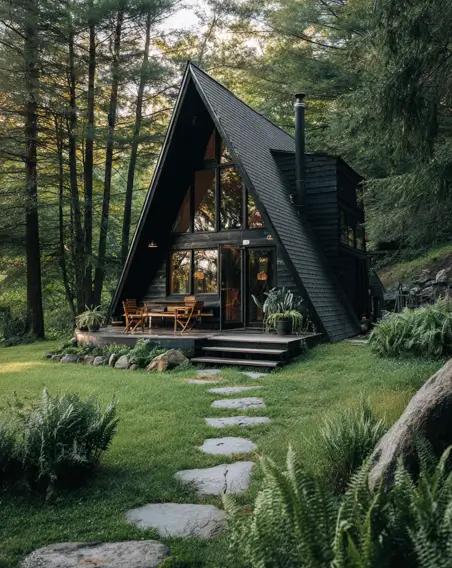
Designing a seamless transition between indoors and out is key for small-space living. This modern A-frame tiny house extends its footprint with a simple wooden deck, creating an inviting outdoor room for dining or relaxing that is directly connected to the main living area.
34. Frame the Landscape with an A-Frame
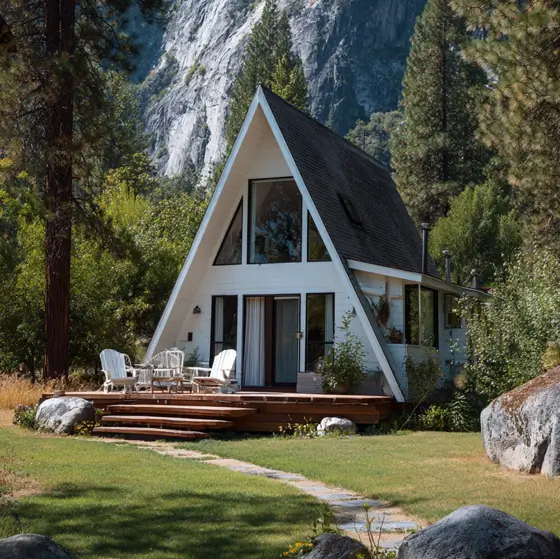
A-frame architecture is ideal for capturing breathtaking scenery. The iconic triangular shape naturally creates a large window that perfectly frames the majestic mountain backdrop, making the view the undeniable focal point of the entire design, both inside and out.
35. Opt for Modern Farmhouse Style
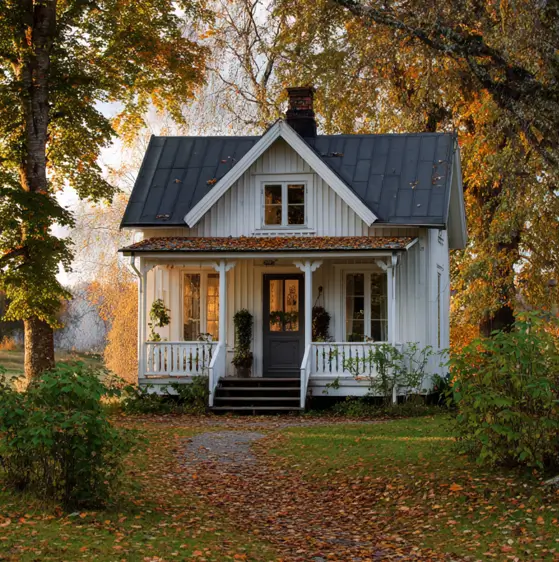
Simple forms and a high-contrast palette are hallmarks of modern farmhouse design. This tiny house combines classic white vertical siding with a dark standing-seam roof for a clean, graphic look. The understated design feels both contemporary and timeless.
36. Embrace an Open-Air Feel

Clean lines and natural materials define this modern tiny house. A flat roof with a warm wood-paneled overhang creates an inviting outdoor space, while large windows and glass block details flood the interior with light for a bright, airy, and open feel.
How to Design a Tiny House Interior That Feels Big
A beautiful exterior is only half the story. The true success of a tiny home lies in an interior that feels spacious, smart, and stylish. Follow these guiding principles for your tiny house layout.
1. Prioritize a Smart Layout
An effective layout is the foundation of a great tiny house. This is the most critical stage for developing effective tiny house floor plans, especially if you are considering a tiny house on wheels design which requires careful weight distribution. Prioritize an open-concept design and consider a loft to free up floor space.
2. Choose Multi-Functional Furniture
In a tiny home, every piece must earn its place. From my experience designing small spaces, the biggest mistake people make is choosing furniture that isn’t scaled correctly for the room.
- Living Area: Opt for space-saving furniture like sofas with hidden storage, coffee tables that lift to become dining tables, and nesting benches.
- Bedroom: A murphy bed that folds into the wall can transform a bedroom into a home office or creative space during the day.
- Dining: Choose a drop-leaf table that can sit flush against a wall or expand to accommodate guests.
3. Integrate Smart Storage Solutions
Think vertically and creatively to eliminate clutter.
- Use wall space: Install shelves above windows and doorways.
- Integrate into architecture: Build custom storage drawers into staircases or under bench seating.
- Think creatively in the kitchen: A compact kitchen layout requires smart thinking. Use magnetic strips for knives, under-shelf baskets for produce, and wall-mounted racks for pots and pans.
- Consider the Loft: A well-designed loft is a classic tiny house feature. Focus on creating safe access and consider built-in storage for your loft bedroom ideas.
Expert Tip: Don’t forget about toe-kick drawers under your kitchen cabinets. It’s one of the most overlooked storage opportunities in a tiny house.
4. Create an Illusion of Space
Make your tiny home feel larger than its square footage.
- Light Color Palette: Use whites, soft grays, and pastels to reflect natural light and make the space feel open and airy.
- Strategic Mirrors: Place a large mirror opposite a window to create an illusion of depth and bounce light around the room.
- Layered Lighting: Ensure your lighting plan includes ambient overhead lighting, focused task lighting (like under-cabinet strips or a reading sconce), and soft accent lighting to create warmth.
Practical Considerations for Your Tiny House Design
After the inspiration comes the planning. Addressing these practical realities early on will ensure your tiny house journey is a smooth and successful one.
Budgeting for Your Build
Tiny house costs can range widely, from a few thousand for a DIY build using reclaimed materials to over $100,000 for a custom, high-end model. Key factors include the cost of a trailer, the quality of finishes, and whether you’ll need to hire professional help for plumbing or electrical work. It’s wise to budget an extra 10-15% for unexpected expenses.
Navigating Zoning and Regulations
Navigating local laws is one of the biggest challenges. Zoning regulations and building codes vary dramatically between cities and states. A tiny house on wheels (THOW) is often classified as an RV, while a home on a permanent foundation must meet different local building codes. Always research your local municipal ordinances thoroughly before you begin your build.
Frequently Asked Questions
What is the best way to maximize space in a tiny house?
The best way is to combine vertical storage (using the full height of your walls) with multi-functional furniture (like a sofa with hidden storage or a lift-top coffee table). This ensures every inch of your tiny house layout serves a purpose.
How can I make my tiny house not feel cluttered?
The key to a clutter-free tiny home is dedicated storage. Every single item must have a designated home. Embrace a minimalist mindset and regularly declutter. Smart space-saving solutions like integrated storage are essential for maintaining a sense of order and calm.
What are the most popular exterior styles for tiny homes?
The most popular tiny home exterior ideas include Modern Farmhouse (clean lines, high contrast), Rustic Cabin (natural wood, cozy feel), Classic Cottage (charming, storybook details), and Modern A-Frame (dramatic rooflines, large windows for scenic views).
What are some design ideas for an off-grid tiny house?
For an off-grid tiny house, focus on integrating solar panels into your roof design, planning for water collection and filtration systems, and choosing energy-efficient appliances. Many off-grid tiny house ideas also incorporate a composting toilet to minimize environmental impact.
Finding Your Perfect Tiny House Design
Ultimately, the best small home design is one that reflects your personal style while cleverly accommodating the realities of your daily life. It’s a creative exercise in prioritization, resulting in a home that is not just smaller, but smarter, more intentional, and a true reflection of you.

